Biography
Interests
Tayyib, N. A., Khedr, S., Fawzi, N., Eldin, E. E. & Lindsay, G. M.*
College of Nursing Studies, Umm Al-Qura University, Makkah, Saudi Arabia
*Correspondence to: Dr. Lindsay, G. M., College of Nursing Studies, Umm Al-Qura University, Makkah, Saudi Arabia.
Copyright © 2019 Dr. Lindsay, G. M.,, et al. This is an open access article distributed under the Creative Commons Attribution License, which permits unrestricted use, distribution, and reproduction in any medium, provided the original work is properly cited.
Abstract
WhatsApp Messenger is a popular and free messaging service providing instantaneous distribution
and sharing of written, audio and video materials within a predefined group independent of
location. This paper reviews the benefits and limitation of using these facilities of WhatsApp within
undergraduate nursing education.
The Google Scholar, Pubmed and CORE databases were searched for applications of WhatsApp
Messenger in undergraduate nursing programmes. Search results were distilled down into ten
articles using the PRISMA methodology.
Three important benefits of WhatsApp and one limitation were identified. Student nurses appreciated
how WhatsApp facilitated the instantaneous distribution and sharing of written, audio and video
learning materials within a private learning group. They thought that WhatsApp benefitted the
social integration of their learning community and helped to reduce feelings of social alienation and
professional isolation felt by some student nurses when on nursing placements. They also thought
that WhatsApp helped to address various issues of professionalism and professional development.
The availability of free access to a network capable of maintaining continuous connectivity was
regarded as the primary limitation in the use of WhatsApp as an m-learning platform.
Nursing students were positively inclined to the use of WhatsApp as an m-learning tool, particularly
within the contexts of nursing placements and maintaining professional identity. However,
WhatsApp has been largely used in an ad-hoc way taking minimal recognisance of educational
theory. In overview, the current literature recommends studying the capabilities of WhatsApp as an
m-learning tool over a wider range of educational perspectives across the nursing curriculum and
in clinical practice, and testing the quality and retention of the knowledge taught using WhatsApp.
We make two further recommendations. First, WhatsApp‘s use should be considered within the
recognised guidelines for good educational practice. Second, because m-technology is a dynamic
field with rapidly changing capabilities, users should be proactive in exploiting the full potential of
the technology.
Introduction
The use of ’smart phones’ and their extended communication capabilities are widely used in everyday life
for many purposes including searching for data, maintaining contact and circulating information. Although
voice and text conversations remains their primary use, enhanced smart phone devices offer a wider range
of connectivity possibilities [1,2] with a range of available functions and capabilities that depend on the
features and applications (or “apps”) ranging from web browsers and email clients to applications designed
for specialist use, e.g. controlling a domestic security system from any location.
The emergence of the term “m-learning” (mobile learning) gives an indication of the popularity of mobile phone devices in learning, as an addition to the existing e-learning (electronic learning) which refers to learning facilitated through some form of electronic technology [3]. Indeed recent evidence suggests that social media activities are marginally diminishing with greater use of messaging applications and the creation of private messaging groups such as can be achieved using WhatsApp [4] (see appendix), particularly in the workplace and educational environments [2,5].
A growing number of educational institutions and health providers are exploring how best to take advantage of the developing social/messaging technologies [6]. Examples are the use of WhatsApp for the teaching of an undergraduate Physiology course [7], the use of mobile phones and social media to facilitate education and support for rural-based midwives in South Africa [8], the use of WhatsApp as a tool to supplement medical education for medical students on clinical attachment [9] and NHS England’s decision to relax its position on the use of WhatsApp by clinical staff provided patient information is not discussed [10].
However, the scientific literature on the use, acceptability and impact of specific messaging applications is still developing [11]. Because these technologies evolve over relatively short time scales, agility in taking account of what has been reported in the literature and what is available is important in order to keep abreast of rapid practice changes and be aware of how to take best advantage of developing resources. This article provides a systematic review of published literature between 1st January 2015 and 31st March 2019 on the use of WhatsApp Messenger [4] in undergraduate nursing education and provides specific guidance for the use of the WhatsApp platform within small group-work learning.
Methods
A systematic review of the literature on the use of m-learning using WhatsApp messenger in nursing
education was undertaken. The review was conducted following the principles and recommendations outlined
in ‘The Preferred Reporting Items for Systematic Reviews and Meta-Analyses’ protocol (PRISMA) [12].
Searches of the electronic databases Google Scholar, CORE [13] (The World’s Largest collection of open
access research papers) and PubMed between 1st January 2015 and 31st March 2019 were conducted on the
options “in title” and “in text” using the criterion “Nursing” AND “ WhatsApp” AND “smart-phone” OR
“mobile” NOT “Facebook” NOT” Instagram” NOT “Twitter” NOT “Linkedin” NOT “Medical”.
Fifty eight and one hundred and ninety four articles were identified from the “in title” and “in text” searches respectively. Duplicated articles, article not written in English, articles not pertaining directly to education and conference reports of already included journal articles were eliminated leaving a total of twenty five articles for individual inspection. Various criteria (see Figure 1) eliminated a further fifteen articles leaving ten articles between the dates of 1st January 2015 and 31st March 2019 for detailed discussion.
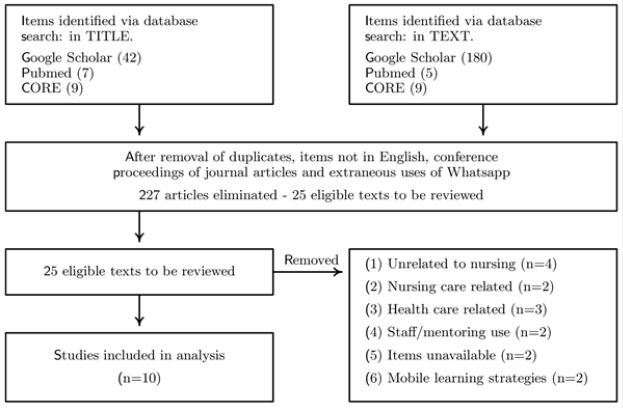
Findings and Conclusions
The key components of the individual articles identified from the scientific literature by the systematic review
are summarised and presented in Table 1. The majority (6 out of 10 articles) of the literature identified using
the search criteria listed in Figure 1 were exploratory or descriptive in nature with only four investigations
using an experimental process (design with potential to identify statistically significant differences in
variables measured [14-17]).
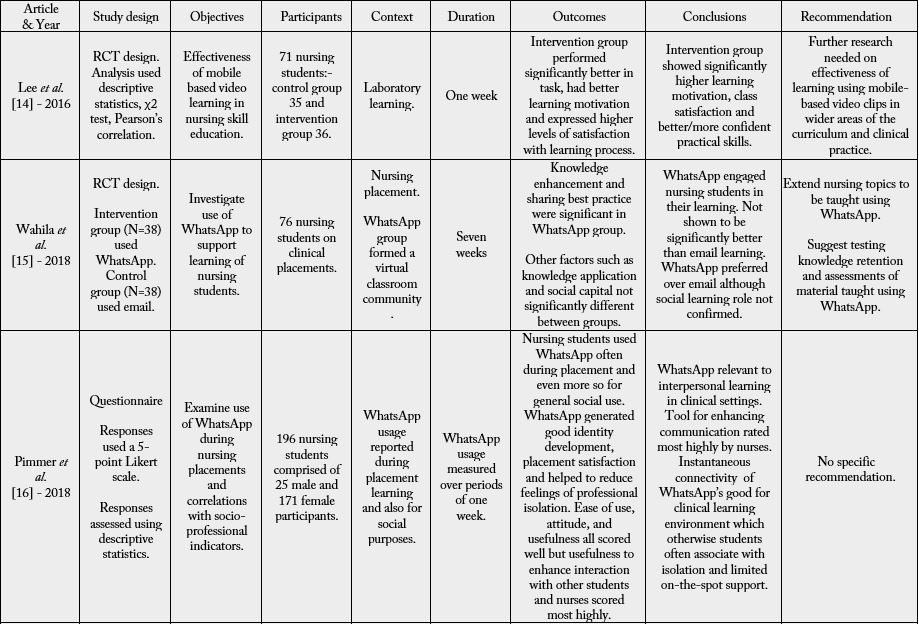
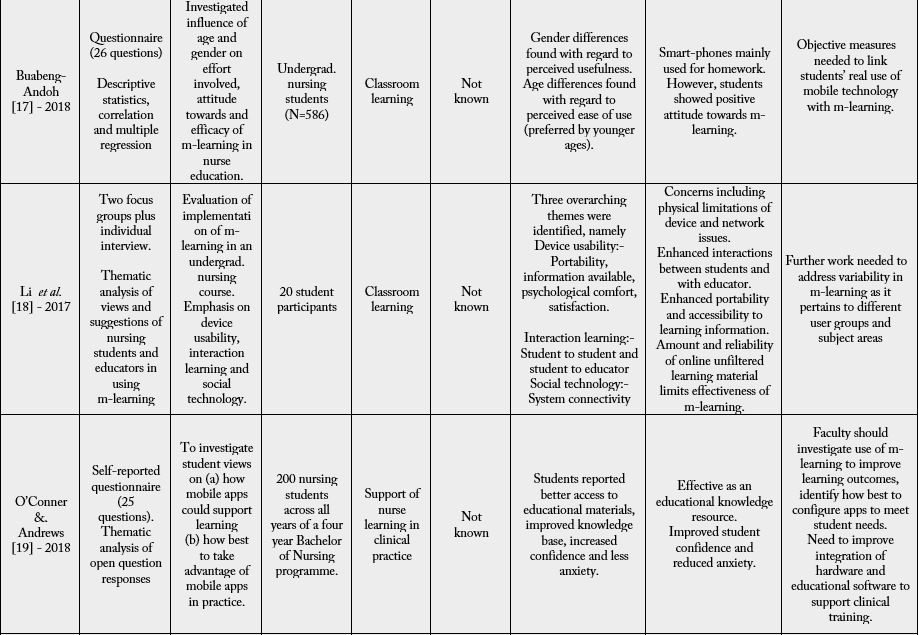
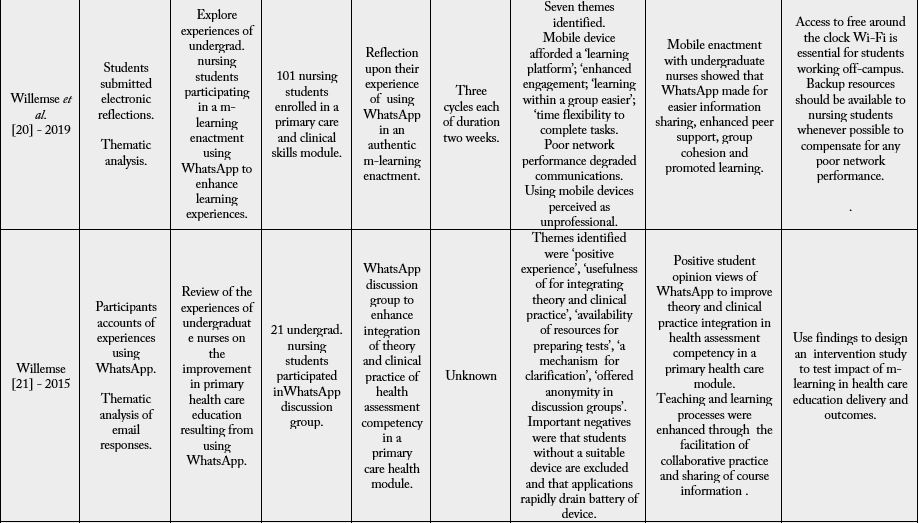
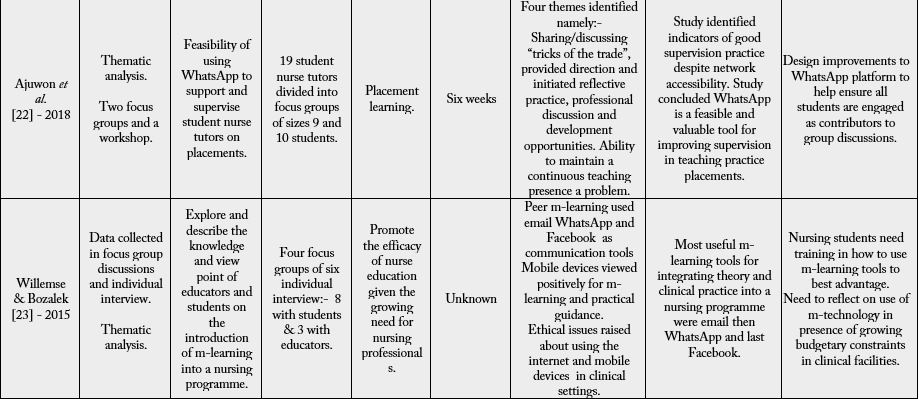
The findings from these studies are further discussed in groupings according to their study design.
The effectiveness of WhatsApp as an m-learning tool for delivering traditional laboratory/classroom teaching
material within a virtual laboratory/classroom was investigated using randomised control trials. One
trial divided 71 nursing students at random into a control group of 35 and an intervention group of 36
participants [14]. The control group was taught a practical nursing task within a laboratory setting, whereas
the video of the practical nursing task being taught to the control group in the laboratory was distributed to
the intervention group (who had not attended the laboratory demonstration). Over the following week the intervention group used WhatsApp’s video capability to teach themselves the same task. On completion of
the trial it was concluded that the intervention group performed significantly better than the control group
in terms of higher learning motivation and class satisfaction in learning and performing the practical nursing
task.
In another trial 76 nursing students on clinical placements of seven weeks duration were divided randomly into control and intervention groups of 38 students [15]. The control group was taught by email while the intervention group received the same instruction, but communicated using WhatsApp. Although students preferred to use WhatsApp over email as the teaching medium, on completion of the study no conclusive evidence was found to support the view that WhatsApp was a more effective teaching tool.
The effectiveness of WhatsApp as an m-learning tool for facilitating interactions between students, their
educators and their peers was investigated as a supportive mechanism for combating the drop-out resulting
from unsatisfactory clinical placements in nursing education programmes [16]. Students’ perceptions of
WhatsApp were measured on a 5-point Likert scale and collected on a weekly cycle from questionnaires
issued to 196 (F=171,M=25) nursing students during their nursing placements. Responses were elicited
across twelve domains including ‘usefulness for placement work’, ‘general use’, ‘social capital’, ‘professional
isolation and identity’, ‘placement satisfaction and ease-of-use’ among others topics. Responses were analysed
using descriptive statistics. The study concluded that WhatsApp generated good placement satisfaction
with strong development of identity and reduced levels of professional isolation. Ease of use and attitude
scored well with WhatsApp’s perceived usefulness to enhance communication with other students and
educators scoring most highly.
Another descriptive study investigated how age and gender influenced students’ perception of WhatsApp when used for m-learning across various classroom tasks [17]. A 26 item questionnaire was issued to a gender balanced group of 600 undergraduate nursing students, approximately 50% of whom were aged 21- 24 years with approximately 25% aged 17-20 years and 25% aged 25 years and above. The study concluded that younger students found the WhatsApp platform easier to use and that men thought m-learning to be significantly more useful than women, although no gender difference was observed between the sexes in respect of improved performances using m-learning and its ease-of-use.
The remaining six studies were qualitative and used thematic analysis to investigate various aspects of mlearning
within nursing education. Data for analysis were most frequently collected via focus group discussion
usually involving a cohort of approximately 20 participants followed by individual in-depth interviews,
or in the case of larger investigations, by a thematic analysis of respondent’s emails. The themes identified
could be largely classified as issues of technology, issues of the perceived effectiveness of m-learning as a
teaching tool and issues of professionalism.
One study evaluated the implementation of m-learning in an undergraduate nursing course with regard to device usability and strengthened student-educator and student-student interactions [18]. The study found that m-learning enhanced these interactions, but students raised concerns about the physical limitations of the devices and networks and the reliability of unfiltered learning materials freely available over the internet. Another study sought student views about how mobile apps could support learning, and how best to use these apps in practice [19]. Questionnaires were distributed to 200 (M=16,F=184) nursing students across all four years of an undergraduate nursing programme. Responses were analysed under the themes ‘mobile device and app use’, ‘mobile apps for learning’ and ‘implementation of mobile apps’. Students thought that mobile apps allowed better access to educational materials, improved their knowledge base and increased their self confidence. However, the study concluded that configuring apps to meet student needs will require better integration of hardware and educational software in support of clinical training.
Two studies investigated the role of WhatsApp for m-learning within the context of primary care. One study undertook a three-phase m-learning enactment related to the outcomes of a primary care and a clinical skills module [20] whereas the other study elicited responses from undergraduate nursing students about their experiences of using WhatsApp within the context of primary health care education [21]. Table 2 lists the themes identified in these studies.
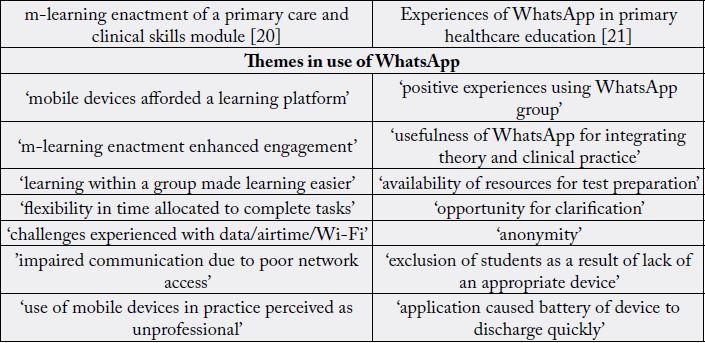
Participants in the enactment study were fourth year nursing undergraduate students (n=101) each of whom submitted their views electronically for thematic analysis at the end of each of three two-week phases. Participants in the primary health care education study were undergraduate nursing students (n=21) who submitted email responses for thematic analysis.
Each study identified seven themes, but no theme was unambiguously common to both studies. However some themes were loosely connected, for example, ‘m-learning enactment enhanced engagement’ and ‘learning within a group made learning easier’ was loosely aligned with ‘positive experiences using WhatsApp group’ and ‘the usefulness of WhatsApp for integrating theory and clinical practice’. The themes ‘challenges experienced with data/airtime/Wi-Fi’ and ’impaired communication due to poor network access’ in one thematic study had no direct equivalent with the themes ‘exclusion of students as a result of lack of an appropriate device’ and ‘the application caused the battery of the device to discharge quickly’ identified in the other study although both fall within the scope of technological considerations.
In overview, students found that the mobile enactment using WhatsApp made for easier information sharing, but with the caveat that access to free high quality Wi-Fi is essential. They also thought that WhatsApp enhanced peer support, group cohesion and promoted learning within an enjoyable environment. The primary healthcare education study concluded that the virtual environment provided by WhatsApp facilitated the sharing of course materials and supported/enhanced the teaching and learning process leading to better integration of theory and clinical practice in a primary healthcare module.
Of the remaining two studies, one explored the ability of WhatsApp to provide support on teaching practice placements within an informal learning environment [22] and the other elicited students’ and educators’ viewpoints on the introduction of m-learning into an undergraduate nursing programme [23]. The themes identified in these studies are listed in Table 3.
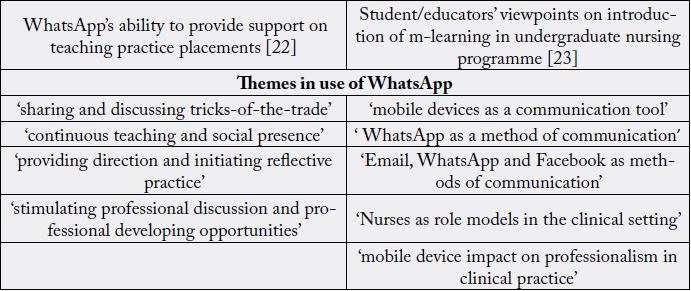
Four themes were identified in the investigation of WhatsApp’s ability to provide support on teaching practice placements, whereas five themes were identified in the investigation of student/educators’ viewpoints in relation to the introduction of an m-learning nursing programme. No direct commonality exists between the themes raised in each study although loose alignments are again present, for example, ‘stimulating professional discussion and professional developing opportunities’ can be loosely aligned with ‘mobile device impact on professionalism in clinical practice’ and ‘providing direction and initiating reflective practice’ can be loosely aligned with ‘Nurses as role models in the clinical setting’.
With regard to WhatsApp’s ability to provide support on teaching practice placements, the study concluded that despite technical challenges, WhatsApp was a feasible and useful platform for enhancing supervision during teaching practice placements or in situations where face-to-face interactions are difficult or impossible. In respect of student/educators’ viewpoints on the introduction of m-learning into an undergraduate nursing programme, the study concluded that email was the most useful learning tool for integrating theory with clinical practice followed by WhatsApp and lastly Facebook, although there was evidence that the WhatsApp and Facebook platforms were not being used to best advantage. Students also raised ethical issues concerning the use of the internet and mobile devices in clinical settings.
Discussion of Findings
This systematic review was undertaken to investigate the evidence-base and experiences of the use of
WhatsApp m-learning in undergraduate nurse education. As noted following the search process, the studies
identified were mostly of a descriptive or qualitative nature (see section 3). This highlights that in this rapidly
developing technology that new developments are not founded on a highly investigated evidence-base for
use in practice and may be led more by market forces and less by scientific consumer feedback. To move
from an ad hoc to a sound scientific basis requires the evidence base to move from a descriptive context to
a sounder scientific basis.
All studies reported that undergraduate nursing students found WhatsApp Messenger easy to use. One study [17] across a wider spectrum of ages within a gender balanced population suggested that younger individuals, independent of gender, found WhatsApp marginally easier to use than older students. Interestingly this study reported that men found m-learning to be more useful than women although this difference was not manifest in different enhancements in performance between the sexes. Setting aside the issue of ease-of-use, the overlapping findings of the ten studies considered in this survey may be succinctly summarised under several general headings.
All studies reported that nursing students thought WhatsApp to be an effective tool for instantaneously
sharing learning and operational information such as written and video materials particularly if the latter is
task oriented [14]. WhatsApp was thought to help to strengthen interactions between students and their
peers and educators and made group working easier and more enjoyable [18]. However, no convincing
evidence was found that WhatsApp was more effective than email for communicating learning materials
[15], and indeed some evidence suggested the contrary, namely that email was a more effective tool for
integrating nursing theory and practice than either WhatsApp or Facebook [23] despite nursing students
preference for the WhatsApp platform.
Unsatisfactory nursing placements were thought to be an important driver of drop-out from nursing
education programmes [16]. Nursing students thought that WhatsApp was particularly suited to the nursing
placement work that forms an integral part of all undergraduate programmes of nursing education. Nursing
students valued the instantaneous connectivity WhatsApp made possible with their educators and with
their peers, and thought that this instantaneous connectivity enhanced the teaching and learning process
[21]. Essentially, WhatsApp integrated their placement within a virtual classroom teaching environment
thereby introducing a sense of belongingness, reducing feelings of isolation and reinforcing professional
identity as well as providing a mechanism for obtaining on-the-spot professional guidance [16].
Nursing students thought that the use of WhatsApp helped to strengthen interactions with their educators
and with their peers [18], improved their self-confidence [19] and enhanced group cohesion within an
enjoyable learning environment [20]. In the context of nursing placements, where face-to-face interactions
are impossible, students thought that these issues might be problematic in the absence of WhatsApp [22].
Issues of concern raised by nursing students could be classified as either technological or ethical. Central
to the effective functioning of WhatsApp as an m-learning platform is the availability of a suitable mobile
device for each participant of a learning group in combination with free access to a network capable of
maintaining continuous connectivity [18-20,22]. Undergraduate nurses also questioned whether or not
the use of WhatsApp in a clinical environment breached ethical standards [23]. This question has surface
elsewhere in clinical care and been addressed. For example, NHS England [10] decided to lift their embargo
on the use of mobile messaging services such as WhatsApp in the clinical environment provided users do
not discuss patient information.
Two issues relevant to nurse education are not reported in the literature. First, no guidance is reported for
the ‘formal processes’ for the use of WhatsApp within the nurse education curriculum, which means that
the application is used on an ‘ad hoc’ basis. Second, the wider capabilities of WhatsApp remain unreported.
For example, in learning which involves group collaboration focussed on a topic area, the content of the
interactions could be analysed utilised and used as the basis for report generation. The system has the
ability to store the complete history of group interactions, to track group discussions and allow these to
be summarised as a narrative for future inspection and appraisal. Skills and knowledge deficits could be
identified and used to inform and support learning. With the correct permissions in place, this recall feature
of WhatsApp allows the group to gain greater understanding of the learning process by comparison with
lost discussions, summary notes or audio transcriptions that are onerous to analyse.
In overview there are several important recommendations from the authors of the literature within the
systematic review (Table 1). It is recommended that the capabilities of WhatsApp as an m-learning tool
should be investigated through further research over a wider range of educational perspectives across the
nursing curriculum and in clinical practice. Furthermore, it is recommended that research should also focus
on testing the quality and retention of knowledge taught using WhatsApp. This would help to improve
understanding of its efficacy, strengths and limitations as an m-learning tool across various user groups. The
main concerns in using WhatsApp as an m-learning platform were related to hardware capability and the
reliability of network performance. These led to the recommendation that to be fully effective, m-learning
tools required 24 hour WiFi coverage with additional backup through access to relevant alternative resources.
The recommendations in Section 4.1 arising from individual studies from the literature are supported by
the investigations undertaken. In terms of generating further understanding from the systematic review of
selected research studies and current educational practice in undergraduate nursing, we propose two further
recommendations.
Consider using WhatsApp within recognised guidelines for educational practice. For illustration, in successful
educational team work within small group learning communities there are a number of factors that have
been widely identified as being key ingredients for productive working [24,25]. The use of WhatsApp as
a platform for conducting small group learning communities with reference to the role components for
facilitator and participants is summarised in Table 4.
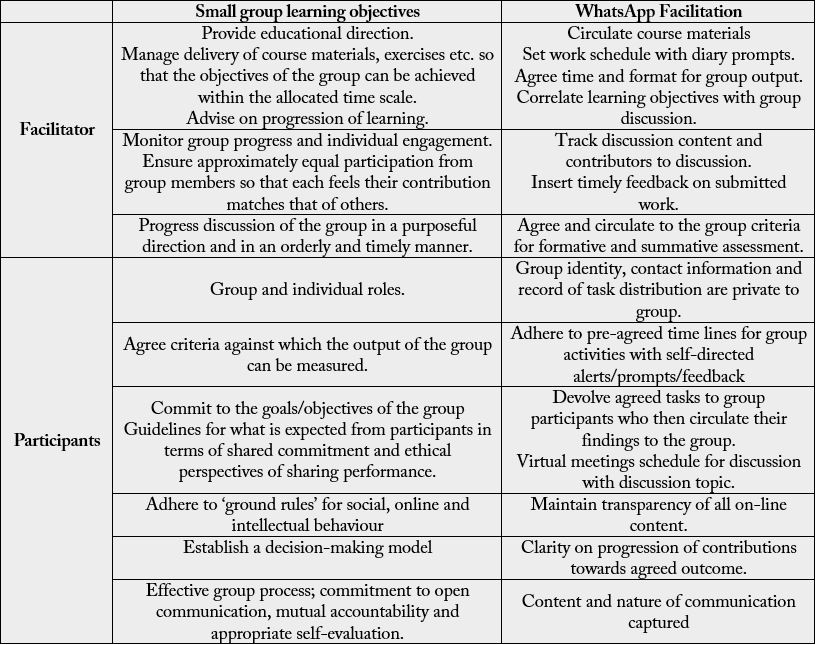
M-learning has emerged over a relatively short time frame. It is likely future developments will be as rapid.
Institutions and individuals would benefit from a heightened awareness of these trends and emergent capabilities
that are already becoming evident in related areas of digital advancement and machine learning [26].
As digital capabilities become even ’smarter’, systems could be envisaged that possess the capability for analysing
content and providing direction within m-communications, that react to provide prompts and links to
other relevant resources and functions as interconnectivity of devices advances. Educators should be aware of
how this growing capacity will allow mobile devices to be used in a more powerful manner within education.
Conclusions
M-learning in nursing is a relatively new field of study. Student perceptions of WhatsApp as an m-learning
platform are positive. Student nurses agreed that WhatsApp was a useful tool for integrating theory and
clinical practice, making learning easier through its support for learning within a group and was generally
rated highly satisfactory. Students thought that the instantaneous connectivity provided by the WhatsApp
platform was particularly important for students during nursing placements, a necessary component of undergraduate
nursing education, but one that is thought to be an important contributor to student drop-out
when placements are unsatisfactory. As well as providing a mechanism for seeking on-the-spot professional
guidance, its virtual classroom environment helped reduce feelings of social and professional isolation and
helped to reinforce professional identity.
The IT industry is largely driven by technological developments and feedback from its customer base, but not from scientific literature. Arguably this occurs because the time needed to develop scientific investigations is significantly longer that some industry timescales. Therefore in order to apply findings from ‘fast-feedback’ type research into wider practice applications, users need to draw on professional judgement in the absence of sound science. To do so would enhance the theoretical basis of using WhatsApp as a teaching tool. To ensure the integration of technology does not lose the theoretical basis for learning, reference should be made to educational learning approaches to manage learning in WhatsApp-facilitated group work, and to augment traditional classroom group-learning approaches.
Limitations
We note that the reviewed literature on the use of WhatsApp in nursing education is limited in scope, with
a predominance of research which is descriptive and exploratory. Recommendations within the individual
studies and from the systematic review support the need for further research. It could be argued that the
review is already weak, because of the limited research that has been undertaken. However, this review
provides a detailed systematic account of the research findings that exist and goes further to suggest ways
of enhancing the use of WhatsApp with reference to the theories allied to the context of its use; in this case
small group work learning in nursing education.
The quality of the individual papers used in this systematic review relies on the PRISMA [12] process of literature searching. Further databases could have been explored although the major literature databases were included and considered to contain the majority of any works published in the time frame indicated as could alternative messaging systems. However it was considered that WhatApp’s has a unique set of attributes and user functions that to understand its impact it was important to examine its use in isolation.
Appendix
Briefly, WhatsApp [4] is owned by Facebook and can be downloaded free of charge to a compatible mobile
phone or tablet without the need for registration. The initial use of WhatsApp requires the phone/tablet
to have an installed sim card allowing WhatsApp to become associated with that phone number via a
verification process. The phone number becomes the ‘username’ and the account is locked to that phone
although contacts can be transferred to a new device. Once installed and verified, the sim card is no longer
used by WhatsApp. Sim cards can be changed on that device without affecting the operation of WhatsApp.
Although WhatsApp shares some functionality with social networking applications, including limited social interaction in individual and group use, sharing of video materials and real-time location, it is a private messaging application [27] and therefore requires communicating participants to have WhatsApp installed on their Smart Phones and to know each other by some route before a WhatsApp connection can be established. Because WhatsApp uses ‘data’ to send messages its operating costs are often significantly less than texting although this may vary if using the ‘roaming’ facility. The roaming facility, however, may be useful for transmitting information from any location, for example, to meet friends in a crowded area. WhatsApp can also be linked to a desktop computer or laptop allowing files (e.g. teaching materials) to be instantly and seamlessly transferring from educator to a group by the mechanism of drag and drop. This contrasts with the more unwieldy operation of distributing material by email. WhatsApp also stores a complete history of group interactions thereby allowing the group to track discussions, allowing these to be summarised as a narrative for future inspection and appraisal.
• Stores contacts as individuals and named groups.
• Communicates quickly with individuals and group members.
• Replaces emails with instant messaging.
• Text exchange of words, narrative or phrases between two or more individuals or groups.
• Select a message in a chat and reply directly to it.
• Delete messages that you may have sent in error.
• ‘Reply Privately’ while in group chat allow one-to-one messaging only.
• Share current live location using GPS over messages in real time.
• Connect with individuals world-wide without incurring international charges.
• Voice messages; Private online video calling (not universally available)
• ‘Everyone (Public) to My Contacts or Nobody (Private).
• Users should be at least 16 years of age
• Location sharing: allows your movements to be tracked by another person in contact with. You have the
option of 15 Minutes, 1 Hour or 8 Hours to decide how long you would like to share your real-time location.
This feature should only be used with individuals you know and trust.
Acknowledgements: None.
Conflict of Interest: None.
Ethical Statement: No ethical approval was required for this work.
Bibliography

Hi!
We're here to answer your questions!
Send us a message via Whatsapp, and we'll reply the moment we're available!